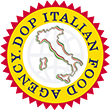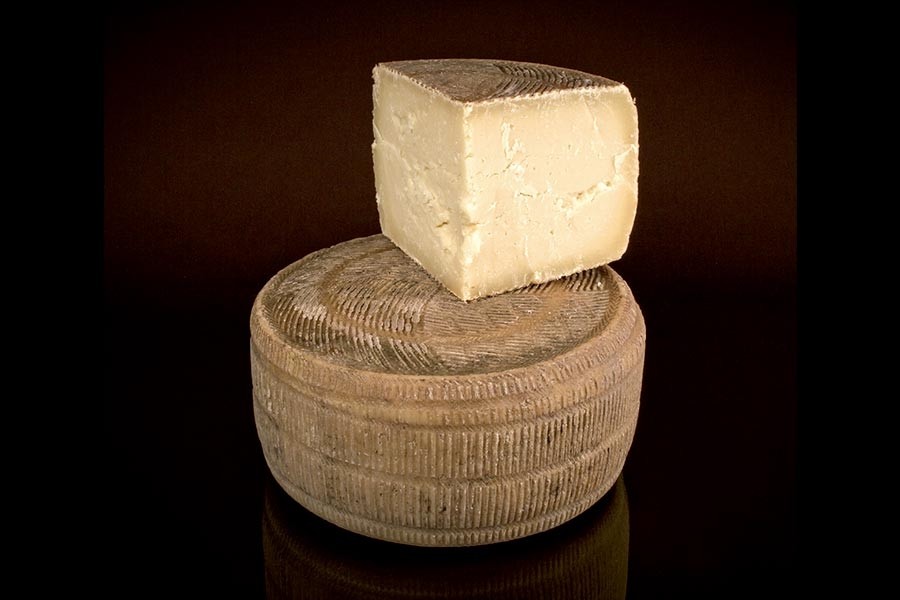Canestrato Pugliese Cheese P.D.O.
Product description
Canestrato Pugliese PDO is a hard cheese produced with sheep’s milk, formed with particular molds that give the cheese its characteristic appearance.
Production method
Animal curds are added to the whole sheep’s milk, which is brought to a temperature of between 38 and 45°C.
When the curd reaches the correct consistency, it is broken until the grains are the size of rice grains. After a brief pressing, it is enclosed in a bulrush basket.
The form is pressed again and after 2-4 days it is either dry salted or salted in brine more than once.
The form is removed from the basket and the cheese is left to ripen in a cool environment, producing a younger or more mature cheese depending on the length of the ripening period, which ranges from 2 to 10 months.
Apparence and flavour
Canestrato Pugliese PDO has a cylindrical shape, with a brown to yellow coloured rind that is wrinkled, hard and thick.
The cheese is straw yellow in colour, compact, crumbly, subtly rich and not too elastic, with barely visible coarse eyes.
The taste is characteristic and pronounced, with a fragrant aroma in more ripened forms. The fresh product is more delicate and slightly less salty.
Gastronomy
Canestrato Pugliese PDO is sliced into pieces with a special knife called petto di piccione (pigeon chest) and is then preserved in a moist cotton cloth.
It can be eaten alone, with fruit and vegetables or grated over pasta. Young Canestrato Pugliese PDO is generally served with fava beans, pears and crudités, and is paired with still dry white or rosé wines. Mature Canestrato Pugliese PDO is ideal for freshly grating on stuffed meat rolls or over pasta with meat ragù: for example, traditional Apulia meat sauce, preferably served with traditional regional pasta such as Orecchiette, Ziti, Mezzi Ziti or Lumache.
This cheese can be served as a main course with fresh vegetables like celery, radicchio, chicory, black olives and radish or, alternatively, stewed.
Marketing
The product is marketed as Canestrato Pugliese PDO.
It is sold young and mature, whole, in large pieces and in pre-packed slices.
The smooth side of its rind must bear the designation and the label must bear the product name and the words “Protected Designation of Origin”.
Distinctive features
During the ripening period, Canestrato Pugliese PDO is placed in a traditional basket (canestro in Italian), from which it takes its name.
The basket molds (fiscelle) are made with bulrushes from Apulia, which are sweeter than other species and therefore do not influence the flavour of the cheese.
History
The production of this cheese was linked to the practice of “transhumance”, which is the traditional migration of cows and sheep.
In fact, Canestrato Pugliese was produced between December and May, during the period when flocks and herds migrated from Abruzzo to Apulia, as recorded by Potenza historian and politician Giustino Fortunato in one of his verses: “If you can, beautiful sheep, pass Summer in the Maiella and winter in Pantanella”.
Like other basket cheeses in the South, its fame long remained limited to the production area, only becoming known at national level after the Unification of Italy.
We find confirmation of this back in 1861, on the occasion of the Italian agricultural, industrial and artistic Expo in Florence, where basket cheeses were defined as being “highly appreciated at local level, yet almost unknown in the rest of Italy and not to the people’s taste”.
Producion area
The production area of Canestrato Pugliese PDO is within the entire Province of Foggia and in various municipal areas in the Province of Bari, in the Apulia region.
Operators: 5
Production(KG): 759
Turnover(MLN€): 0,01

 IT
IT 